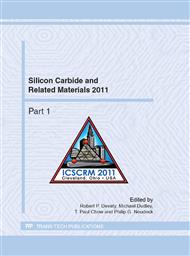p.1097
p.1101
p.1105
p.1109
p.1113
p.1117
p.1123
p.1127
p.1131
Dependence of the Channel Mobility in 3C-SiC n-MOSFETs on the Crystal Orientation and Channel Length
Abstract:
The channel mobility in 3C-SiC n-MOSFETs is investigated by current-voltage and Hall-effect measurements. For comparison, these techniques are also applied to 3C-SiC bulk rods. It turns out that the channel mobility depends on the orientation of the crystal and channel length. The observed results are traced back to the influence of Si-terminated stacking faults (Si-SFs), to the resistance of the drain/source contact and to the warping of the wafer caused by the special growth technique.
Info:
Periodical:
Pages:
1113-1116
Citation:
Online since:
May 2012
Price:
Сopyright:
© 2012 Trans Tech Publications Ltd. All Rights Reserved
Share:
Citation:


